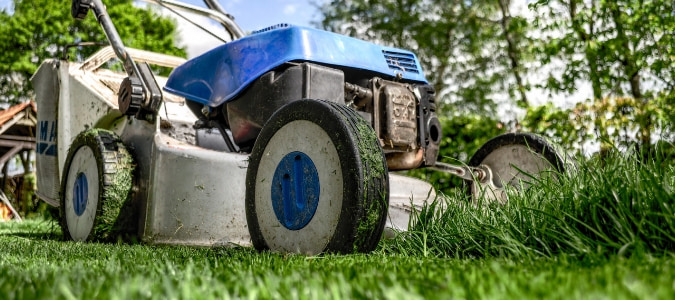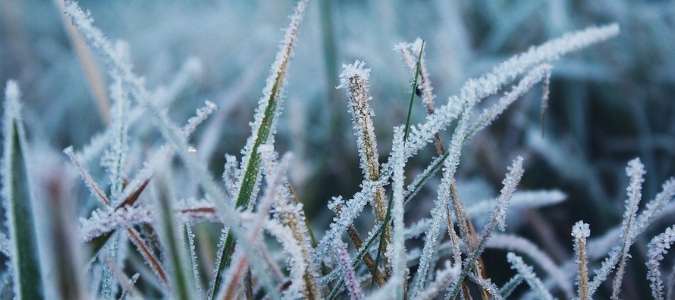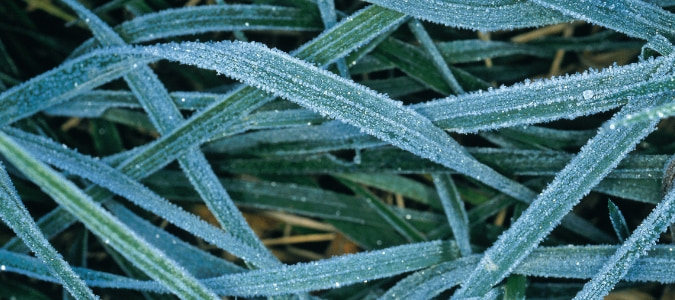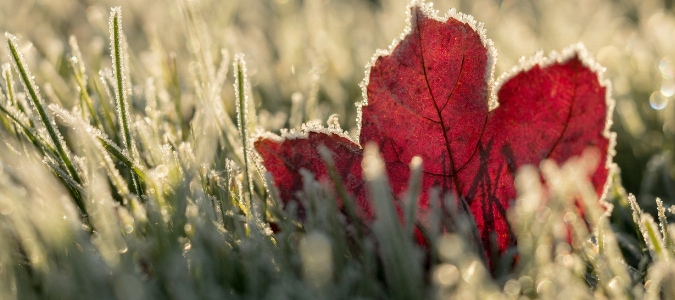
During the winter months, when temperatures across the United States drop for several months at a stretch, most varieties of grass that people use in their yards go dormant—meaning, their active growth cycles slow down. The grass is still alive, but it is in a state of suspended animation. During this time, your yard may lose quite a bit of its bright, deeply green hue. Your plants might even look diseased or dead, and will certainly appear dry. While your lawn might look lifeless, lawn experts will tell you that dormant grass is doing exactly what it’s supposed to do when nutrients aren’t as readily available as they are during the warmer, sunnier months.
Since grass goes dormant in the winter, many people do not need to mow their yards more than a few times throughout the entire winter season and often debate on when to start mowing the lawn again. Where’s the sweet spot? How early or late in the fall can you expect to mow your lawn for the last time of the season? At what temperature does grass stop growing, and how warm does it have to be outside for the grass to “wake up” in the spring and begin growing again?
When it comes to the growth and dormancy phases of grass, the temperature of the soil has more of an impact on the plant via its root structure than the ambient temperature outdoors will have on blades of grass above-ground. The soil temperature when many warm weather grass types stop growing is below 55 degrees Fahrenheit. What does this mean, exactly?
During the winter, people living in Texas or other southern areas of the country might enjoy a warm, springlike day or two, or even an unseasonably warm stretch, but the ground will often continue to stay cooler than usual. Even warmer winter days, after all, are often still followed by chilly nights. In wintertime, the sun is always at a sharper angle to the earth than it is during summer. Since the full force of direct sunlight won’t hit the ground until spring or later, the earth stays cooler overall.
Consistently cooler soil sends a signal to the grass’s root structure that it’s time to go into dormancy. Since the grass’s growth cycle is on pause when it’s in a dormant phase, the lawn should stay neater than usual for well longer than it does in spring and summer. This comes as a welcome break for many homeowners who love the benefits of a beautiful yard, but may not care for the time it takes to mow, rake, plant, weed and perform other assorted landscaping-related duties.
In warmer parts of the country, the period when grass is dormant is understandably much shorter than in the northern states, so the break from mowing your lawn might actually not be very lengthy. As you might imagine, plant growth can also slow down at the other temperature extreme. Some species go dormant when there is no water, others come back after a rainfall, some types stop growing after several hard frosts and other varieties may slow down in the early fall.
Although we’ve explored how and under what conditions grass goes dormant, you probably still want to know more about what point in fall or winter you can expect to mow your grass for the last time of the season. Since cutting your grass is only one part of the lawn maintenance puzzle, you are probably also wondering what other steps should you take to care for your lawn during this dormant phase. Read on to learn more about winter lawn care and how to help your grass weather the cooler months until spring returns.
How Short To Cut Grass Before Winter
A solid understanding of how short to cut your grass before winter comes is the first step in learning how to care for your lawn once colder temperatures arrive. If you cut your grass too short before winter and it stops growing due to the colder weather, your lawn could be damaged by frost or by cold winds that dry out the surface of the grass. If you don’t cut the grass short enough, on the other hand, it will be prone to mold, bacterial growth and rot as chilly winds and cold rains flatten the taller grass, matting it down onto itself and making it retain moisture.
Most lawn care experts agree that for warm-season grasses, such as St. Augustine and Zoysia, between two and three inches is an optimal, safe length to which to cut your lawn at the final mowing of the season. Bermuda grass is also a warm-season grass, but it can actually be cut far shorter—down to a half-inch, if desired, and up to two inches in height for the upper recommended limit.
Mowing for the last time should occur when the grass has stopped growing, which happens when soil temperatures dip below 55 degrees Fahrenheit. Remember, soil takes longer than air to retain or lose heat, so cooler soil occurs after not just a cold day or two, but a good stretch of days with chilly temperatures. In Texas, even in the warmer regions of the state, these conditions usually occur in November or December, making late fall or even early winter a good time to perform your last lawn-mowing of the season. One good sign that grass is going dormant is when the trees have lost at least half of their dead leaves. If you have a mulching mower, you can skip the leaf raking and instead turn all that rich leaf bounty into mulch for your yard.
What’s The Optimal Grass Height For Winter?
The optimal grass height for winter depends on which type of grass you have in your yard. Warm-season grasses, such as Bermuda and St. Augustine, can be cut shorter at winter’s outset than cool-season grasses like fescue or ryegrass.
Generally speaking, individual grass varieties perform better when planted in the region that matches their natural growth pattern. For example, warm-season grasses do better in warmer climates. If you live in Texas or another warm region, and you have St. Augustine or Zoysia in your yard, you can safely cut it down to two inches in length, give or take a half-inch. If you have Bermuda grass, feel free to take it as short as you like, as this is one type of grass that can withstand winter’s cold, drying effects better than other species. If you have fescue or ryegrass growing, however, it’s best to cut it down to about three inches for the winter, as this height is optimal for cool-season grasses.
It’s also important to remember the standard one-third rule of lawn-mowing: Never take off more than a third of the length of the grass when you mow. This bit of lawn care wisdom is followed by many savvy lawn care specialists and home gardeners alike; the main detail here is to remember that, if your grass is long throughout the fall, take it down slowly, observing the one-third rule over the course of two or three lawn-mowings, rather than all at once, since that can harm the plant and inhibit future growth.
Once you’re sure your grass is dormant and you’ve mowed one last time, there is still one more important step to take to help your lawn weather the winter—namely, fertilizing your lawn to encourage lush, thriving grass the following spring.
Cutting Grass Before A Freeze
When you should cut your grass for the last time before winter depends on both when the grass stops growing and when the first freeze occurs. Ideally, you should cut the grass after it has gone dormant, but before the first freeze; unfortunately, this can be a tricky “sweet spot” to determine.
In Texas, the first freeze might be as early as sometime in November or December. In milder years and areas of the state, this milestone may happen as late as January. Cutting grass before a freeze is a good idea; just make sure you don’t cut it too short, as the frost that follows will likely damage it. Also, make sure you don’t cut the grass during a freeze. Cutting freezing, frosty grass can cause stress and damage that will be difficult for the grass to recover from. Cutting grass during a freeze can also result in unhealthy yellow patches on your lawn.
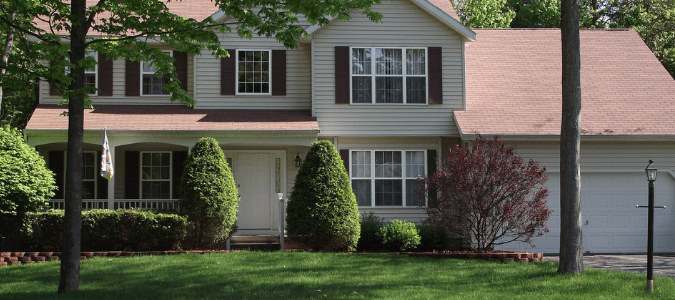
Lawn Mowing In Winter
If you want to protect your landscaping during the cooler months, it’s important to approach lawn mowing in winter with some knowledge about what grass can and can’t handle. Always keep in mind that grass goes dormant after the first couple of hard frosts, after which it’s a good idea to mow one last time and then fertilize. Also keep in mind that, depending on which type of grass you have—a warm-season variety or a cool-season one—you may need to cut your grass down to three inches, two inches or even a bit shorter.
After you mow your yard one last time before winter sets in, it’s also a good idea to clean off your lawnmower. Wipe any dirt or other residue off the blade, and oil the blade if desired. Then store the mower in a clean, dry place, such as inside a shed or your garage, where it will be protected from the elements throughout the winter season.
ABC Maintain Your Yard All Year Long
Lawn care becomes more challenging during the winter months in warmer climates, because our temperature variations can mean our grass rarely goes dormant. In addition, unexpected or sudden freezes or winter storms can leave your yard littered with branches and withering plants just at the time most homeowners don’t want to spend outside doing a lawn clean-up. ABC Home & Commercial Services have been helping Texas homeowners keep their yards looking great for generations. Our specialists know just when to mow as temperatures change, when to stop cutting grass, how to perform lawn restoration and what other winter lawn care and clean-ups will help plants facing the ever-changing conditions that winters can present during the cooler months. With ABC’s help, you can keep your grass and plants healthy and thriving, no matter the season.
